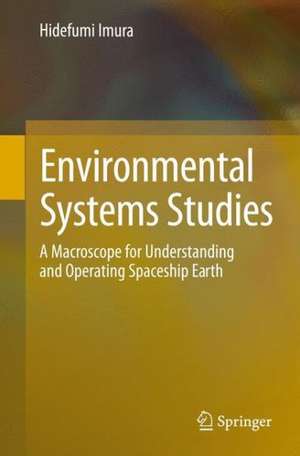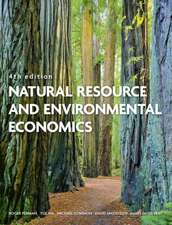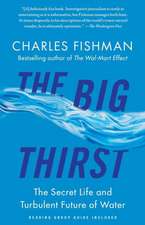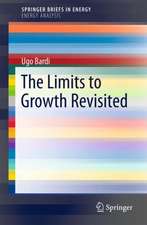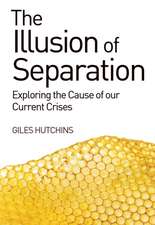Environmental Systems Studies: A Macroscope for Understanding and Operating Spaceship Earth
Autor Hidefumi Imuraen Limba Engleză Paperback – 24 ian 2013
Preț: 384.86 lei
Nou
Puncte Express: 577
Preț estimativ în valută:
73.64€ • 77.30$ • 61.12£
73.64€ • 77.30$ • 61.12£
Carte tipărită la comandă
Livrare economică 10-24 aprilie
Preluare comenzi: 021 569.72.76
Specificații
ISBN-13: 9784431541257
ISBN-10: 443154125X
Pagini: 164
Ilustrații: XII, 151 p. 27 illus., 22 illus. in color.
Dimensiuni: 155 x 235 x 12 mm
Greutate: 0.34 kg
Ediția:2013
Editura: Springer
Colecția Springer
Locul publicării:Tokyo, Japan
ISBN-10: 443154125X
Pagini: 164
Ilustrații: XII, 151 p. 27 illus., 22 illus. in color.
Dimensiuni: 155 x 235 x 12 mm
Greutate: 0.34 kg
Ediția:2013
Editura: Springer
Colecția Springer
Locul publicării:Tokyo, Japan
Public țintă
ResearchCuprins
1. Seeing and Understanding Interactions between Nature and Humanity.- 2. Operating Our Spaceship Earth.- 3. Understanding the Global Climate System.- 4. Biodiversity and Ecosystem Service: Indicators of the Global Environment.- 5. An Evolutionary View of the Environment.- 6. Transforming Our Society: Low Carbon, Coexistence with Nature, and Sound Material Cycle.- 7. The Environment as a Commons: How Should It Be Managed?.- 8. Economics of the Environment.- 9. Resources, Energy, and Environmental Load.- 10. Japan and an Asian Perspective.
Notă biografică
Dr. Hidefumi Imura, Emeritus Professor, Nagoya University
After Hidefumi Imura received his doctoral degree (1974) in applied physics at the University of Tokyo, he joined the Japan Environment Agency and subsequently worked for the Ministry of Foreign Affairs and the Yokohama Municipal Government. After 14 years of being engaged in environmental policymaking in national, international, and local institutions, Dr. Imura moved to Kyushu University in 1988, where he was a professor at the Institute of Environmental Systems until August 2000.
From September 2000 until 2011, he was a professor at Nagoya University, moving to Yokohama City University in 2011. Dr. Imura has a wide range of expertise covering domestic and international environmental policy issues, environmental technologies, economics, and information on Japan, China, and other East Asian countries. His research focuses on energy and material flow analysis of human activities in cities, life-cycle assessment of civil infrastructures, and modeling of human and environmental interactions. Dr. Imura served as a lead author of Working Group III of the Third Assessment Report of the Intergovernmental Panel on Climate Change (IPCC).
After Hidefumi Imura received his doctoral degree (1974) in applied physics at the University of Tokyo, he joined the Japan Environment Agency and subsequently worked for the Ministry of Foreign Affairs and the Yokohama Municipal Government. After 14 years of being engaged in environmental policymaking in national, international, and local institutions, Dr. Imura moved to Kyushu University in 1988, where he was a professor at the Institute of Environmental Systems until August 2000.
From September 2000 until 2011, he was a professor at Nagoya University, moving to Yokohama City University in 2011. Dr. Imura has a wide range of expertise covering domestic and international environmental policy issues, environmental technologies, economics, and information on Japan, China, and other East Asian countries. His research focuses on energy and material flow analysis of human activities in cities, life-cycle assessment of civil infrastructures, and modeling of human and environmental interactions. Dr. Imura served as a lead author of Working Group III of the Third Assessment Report of the Intergovernmental Panel on Climate Change (IPCC).
Textul de pe ultima copertă
The environmental field is deep and wide. In the flood of information, how can people understand the underlying causes of what they hear about the environment from newspapers and television? This book was originally published in Japanese, with the aim of providing basic information about the ideas and methods to see and understand the interconnection between nature and human activities from a systematic point of view. The author subsequently prepared an English version of the same material for use as a textbook for the Global Environmental Leaders Program at Nagoya University, where he taught many students from Asia and Europe. The book covers diverse environmental issues such as climatic change, biodiversity preservation, energy conservation, and resource recycling. Readers can learn common methods of analysis and thinking to identify the core essence of economic and ecological interdependence, to look at problems from an overarching perspective, and to consider countermeasures to be taken.
Caracteristici
Presents a systematic way to understand interactions between nature and humanity Covers various dimensions of environmental issues together with environmental thoughts and methods in just one volume Suitable as textbook for undergraduate and graduate students from diverse backgrounds
